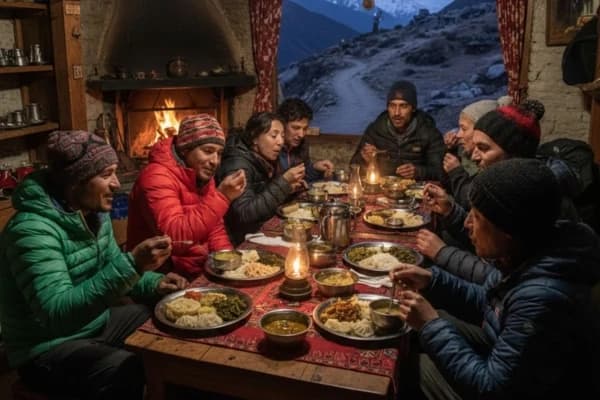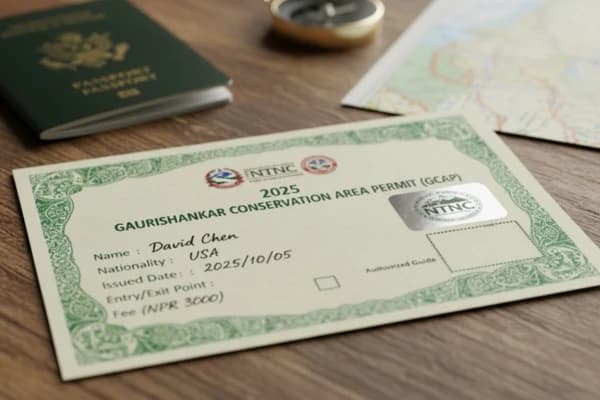Standing tall at 8,848 meters, Mount Everest is the highest peak on Earth—a symbol of human endurance and exploration. Most people are familiar with the southern approach via Nepal. But the North Face of Mount Everest, located on the Tibetan side of the mountain, offers a dramatically different perspective. From its challenging climbing routes to its rich history, spiritual landmarks, and breathtaking viewpoints, this side of the mountain captivates adventurers, climbers, and cultural travelers alike.
Suppose you’re considering visiting, trekking, or even attempting an expedition. In that case, this guide explores everything you need to know about the North Face - from its location and history to permits, routes, costs, and safety tips.
Experience the Himalayas like never before. Let Nepal Gateway Trekking guide you through unforgettable treks around Everest Base Camp and the surrounding trails. Contact us today to plan your adventure!
Facts About the North Face of Mount Everest You Must Know
The North Face of Everest is a unique geographical landmark. A realm of extremes shaped by natural forces and human ambition. Before planning your journey, here are some essential facts.
Where is the North Face of Mount Everest Located?
The North Face of Mount Everest lies in the Tibet Autonomous Region of China, accessible through the Lhasa access route via overland drives from cities like Tingri. The iconic Rongbuk Monastery Everest viewpoint offers one of the closest and clearest views of the face, making it a popular stop for trekkers and climbers.
How Old is the North Face of Mount Everest?
The Himalayas, including Everest, formed around 60 million years ago due to the collision of the Indian and Eurasian tectonic plates. The North Face of Mount Everest has witnessed decades of human exploration, starting with the British expeditions of the early 20th century.
How Cold is the North Face of Mount Everest?
Temperatures on the Tibet side of Everest are extreme year-round. In winter, they can plummet to -40°C, while even in the climbing season, average summit temperatures hover between -15°C and -25°C. These conditions make the Everest north ridge route especially challenging.
What Is the Average Temperature?
The average temperature of the North Face of Mount Everest depends on which season you decide to summit Everest. Let’s take a look at the comparison of the seasonal temperatures for more clarity.
- Spring (April-June): -5°C to -20°C - best climbing season
- Monsoon (June-August): Wet, unstable, often closed
- Autumn (Sept-Nov): -10°C to -25°C - stable weather, fewer crowds
- Winter (Dec-March): -25°C to -40°C - extreme cold, risky conditions
Want to explore Everest from Nepal? Then, Everest Base Camp Trek is your destination.
North Face of Mount Everest - Tibet Route Explained
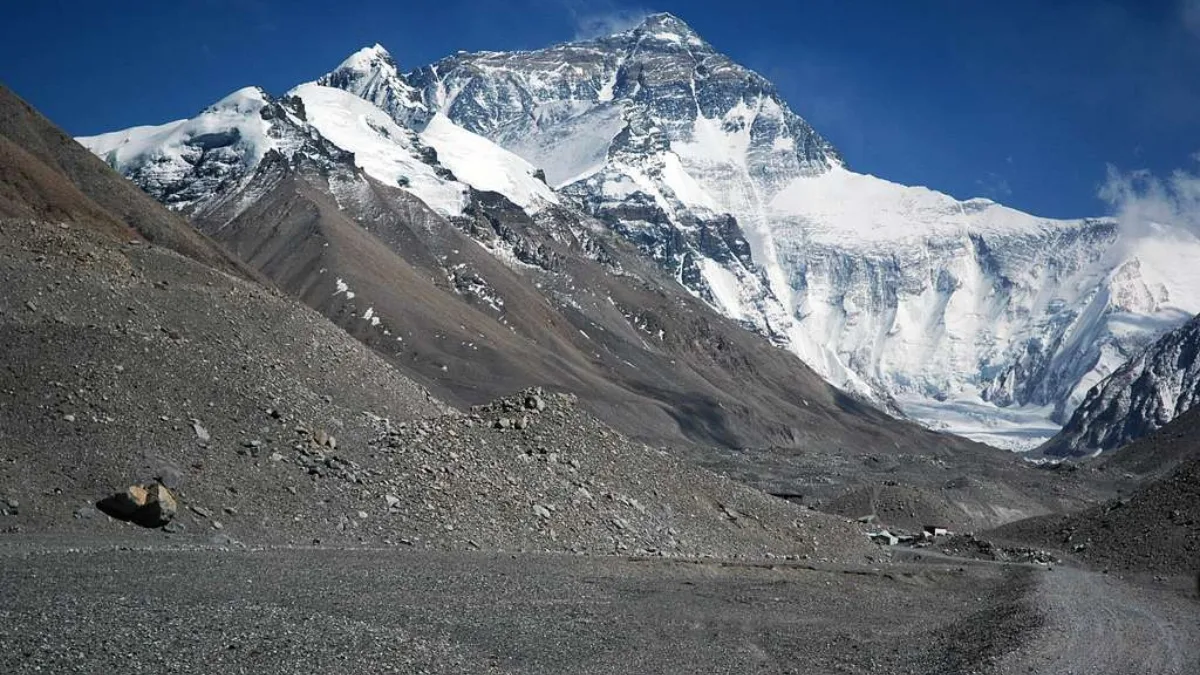
The Tibet side of Everest begins with an overland journey from Lhasa through Tingri, showcasing stunning Himalayan landscapes. Climbers usually visit Rongbuk Monastery on Everest before reaching Everest North Base Camp and then move toward Advanced Base Camp.
This route requires CTMA and Tibet Travel Permits and strict adherence to Chinese regulations. The weather is unpredictable, with strong winds and snowstorms, making late spring and autumn the best climbing windows.
The North Face is very tough. Climbers face steep ridges, tricky paths on the North Col route, and the Three Steps near the summit. But even with all these challenges, climbers still go for it since the views of Tibet, Nepal, and the huge Himalayan mountains are just amazing and totally worth it.
North Face Viewpoint - Rongbuk Monastery
The Rongbuk Monastery, also the highest monastery in the world, sits at 4,980 meters and serves as a spiritual gateway to the North Face of Mount Everest. Established over a century ago, it’s revered in Tibetan Buddhism and provides unmatched panoramic views.
Many travelers stop here on their route to the Everest north base camp, making it a must-see landmark. Accessing the monastery requires a Tibet Travel Permit and an Alien’s Travel Permit, both of which are handled through organized tours.
Immerse yourself in Tibetan culture and panoramic Himalayan views. Explore iconic viewpoints and monasteries near the Everest region with expert guidance.
History of the North Face of Mount Everest
Many people are unaware that the first expedition to Mount Everest began on its North Face. It was done by a British reconnaissance expedition team led by Charles Howard-Bury.
Here’s a timeline highlighting the triumphs and tragedies that make the North Face legendary.
- 1921 - First British reconnaissance expedition led by Charles Howard-Bury
- 1922 - First recorded attempt via the Everest north ridge route
- 1924 - Mallory and Irvine's Everest expedition disappeared near the summit
- 1960 - First successful ascent of Mount Everest from the north col route by a Chinese team of Wang Fuzhou, Qu Yinhu, and Gongbu
- 1980s-1990s - Increased commercial expeditions and guided climbs
What Is the Death Zone on the North Face of Everest?
Above 8,000 meters, climbers enter the so-called Death Zone — where oxygen levels drop dangerously low and survival time without supplemental oxygen is limited. The combination of freezing winds, altitude, and exhaustion makes the Everest northeast ridge among the most perilous routes.
How Many Camps Are on the North Face of Everest?
Climbing Mount Everest from the north face in Tibet follows an entirely different route compared to the south side in Nepal, and it involves fewer but higher-altitude camps. From the Everest North Base Camp at 5,150 meters, climbers gradually ascend through a series of staging and acclimatization camps strategically placed to help the body adapt to extreme altitudes and thin air.
Unlike the south route, which usually has four high camps, the north face typically uses three main high camps above Advanced Base Camp before the final push to the summit at 8,849 meters. Each camp plays a crucial role in rest, acclimatization, and preparing climbers for the next challenging section of the ascent.
What Is the Altitude of the North Face of Mount Everest?
The Everest north base camp is about 5,150 meters high. From there, climbers slowly move up through different camps before finally reaching the top:
|
Camp |
Altitude (meters) |
Function |
|---|---|---|
|
North Base Camp |
5,150 m |
Acclimatization and staging area |
|
Interim Camp |
5,800 m |
Gear transfer and rest point |
|
Advanced Base Camp |
6,400 m |
Climbing prep and route access |
|
Camp I |
7,000 m |
Entry to the North Col route of Everest |
|
Camp II |
7,500 m |
Rotation training and Altitude adjustment |
|
Camp III |
7,900 m |
Final preparation before summit push |
| Summit |
8,848.86 m |
Top of the world |
Best Time to Visit the North Face
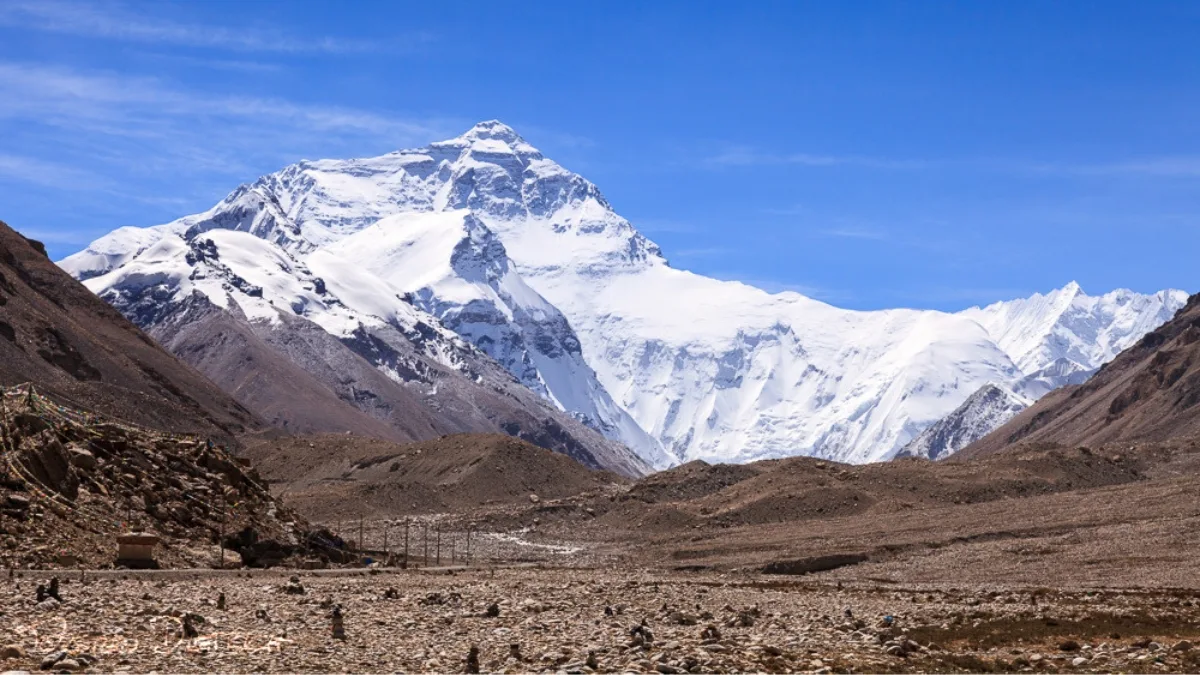
Spring (April to June) and Autumn (Sep to Nov) are the best times for the North Face climb. Picking the right season is super important when planning a trip to the North Face of Mount Everest in Tibet. The weather can change really fast, which can affect how safe it is to climb, how comfy the trek feels, and how clear the views are.
Spring (April - June): Ideal for Climbers & Trekkers
Spring is considered the best time for both expeditions and trekking with its mild weather and clear skies.
- Average temperature: -5°C to 15°C
- Less snowfall, so the paths are safer
- Best time to reach the top: mid-May to early June
- Most people climb during this time so that it can get pretty crowded
Monsoon (June - Aug): Limited Access
Heavy rains make climbing risky, and permits are often restricted.
- Intense rainfall causes landslides and muddy trails
- Frequent cloud cover blocks mountain views
- High risk of avalanches and unstable terrain
- Most expeditions pause operations
Autumn (Sept - Nov): Stable Weather, Fewer Crowds
Second-best season with crisp skies and stunning visibility.
- Avg. temperature: -2°C to 12°C
- Post-monsoon skies are clear and vibrant in colour
- Winds are calmer than in spring
- Ideal for photographers and trekkers
- Fewer climbers than in spring
Winter (Dec - Mar): Extreme & For Experts Only
Harsh conditions make this suitable only for experienced climbers.
- Temperatures can drop below -30°C
- Gale-force winds often exceed 100 km/h
- Heavy snowfall blocks routes
- Requires specialized gear and preparation
- Very few expeditions operate
With the right season and itinerary, you can make the most of your Everest journey. Connect with Nepal Gateway Trekking for tailored trekking experiences, scenic trails, and local insights of Everest from Nepal.
How to Climb the North Face of Mount Everest?
Climbing the North Face of Mount Everest is one of the hardest things in the world. You need a lot of preparation, special permits, and time to get used to the high altitude by stopping at different camps. To make it to the top safely, climbers have to deal with super rough terrain, freezing weather, and the dangerous “Death Zone” above 8,000 meters.
Preparation
- Intense cardio and strength training
- Technical skills for Hornbein Couloir and Norton Couloir sections
- Mental endurance training for harsh conditions
Permits and Logistics
To climb from the Tibet side of Everest, you’ll need:
- Tibet Travel Permit
- Mountaineering Permit from the China Tibet Mountaineering Association (CTMA)
- Alien’s Travel Permit for restricted regions
Costs vary depending on support level; the Everest North Face expedition cost often ranges from USD 35,000 to USD 45,000.
Base Camp Acclimatization
Base Camp Acclimatization for the North Face Mount Everest Climb is a critical step to reduce the risk of Acute Mountain Sickness, also known as AMS, and improve summit success.
Climbers typically spend several days at Advanced Base Camp (6,400 m) and Interim Camp (5,800-6,000 m), following a gradual “climb high, sleep low” strategy, a strategy widely used by every climber to help the body adapt to thin air.
Summit Push
The Summit Push on the North Face of Mount Everest is the final, most demanding phase of the climb. Climbers progress through high camps along the North Col route, carefully timing their ascent to avoid extreme weather.
In the upper reaches of the north face lies the Hornbein Couloir, a steep ice and rock path, only for expert climbers. This legendary route, first climbed in 1963, is extremely technical and rarely attempted today due to its high risk and challenging terrain.
The push involves navigating the technical Three Steps in the “Death Zone” above 8,600 meters while managing thin air, fatigue, and supplemental oxygen to reach the summit safely.
The Summit
The summit of Mt. Everest, standing at 8,848.86 meters, is the biggest reward for climbers after weeks of hard prep and tough high-altitude climbing. From the top, you can see amazing views of Tibet, Nepal, and the surrounding Himalayan peaks, which many say are some of the most breathtaking sights on Earth.
Main Routes on the North Face
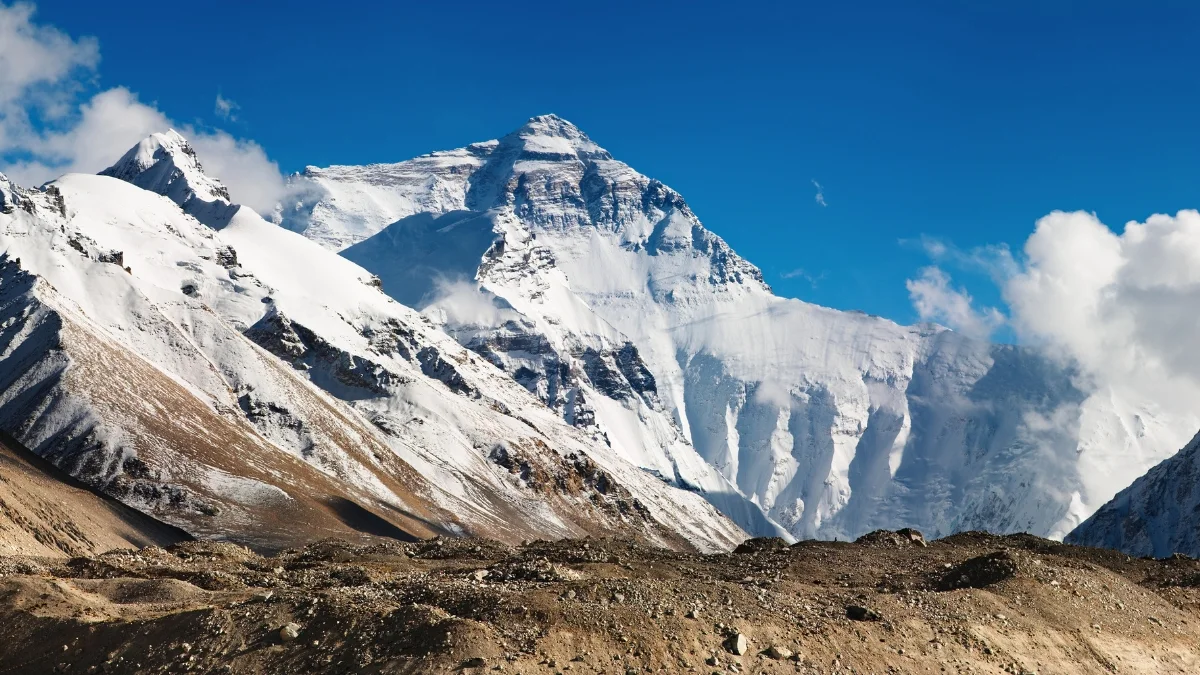
Several routes dominate the Everest north ridge route on the Tibet side of Everest, each offering unique challenges for climbers:
Northeast Ridge - Standard Commercial Route
The Everest northeast ridge is the most popular route for guided expeditions and the main path from the Everest North Base Camp. It follows the north col route to Everest, passing through high camps before reaching the summit.
This well-established route has fixed ropes and ladders, making it safer for climbers with proper acclimatization and permits.
Hornbein Couloir - Technically Demanding, Less Frequented
The Hornbein Couloir is a steep and narrow path on the upper side of Mount Everest’s North Face. Hardly anyone goes this way because of its difficulty. Only pro climbers try it since you need serious ice and rock climbing skills, and there’s a big chance of avalanches.
Norton Couloir - Known for Extreme Exposure
The Norton Couloir stretches from around 8,600 m to the summit, presenting climbers with extreme exposure and high winds. Its sheer vertical slopes make it one of the most dangerous routes on the Everest north face, suitable only for highly skilled alpinists.
Three Steps - Vertical Rock Challenges Near the Summit
The Three Steps are three really steep rock sections on the north col route to Everest, just below the top. Climbers use fixed ropes and ladders to get past them since they’re in the Death Zone above 8,500 meters, where there’s very little oxygen.
Three Pinnacles - Treacherous Ridges Requiring Advanced Skills
The Three Pinnacles are a bunch of sharp, exposed ridges that hardly anyone tries because they’re really hard. This path needs expert rock and ice climbing skills, so it’s only for top-level climbers who want the ultimate challenge on the Tibet side of Everest.
Weather on the North Face of Mount Everest
The North Face of Mount Everest on the Tibet side of Everest is known for extreme and unpredictable weather. Climbers starting from the Everest North Base Camp along the north col route Everest, or the Everest northeast ridge, must plan carefully. Everest permits Tibet, and proper timing during late spring or autumn is essential for a safe expedition.
- Temperatures drop below -30°C in winter.
- Winds often exceed 120 km/h above 8,000 meters
- Sudden snowstorms are common above 6,500 meters
- Clear skies mainly in late spring and autumn
- Narrow climbing windows for summit attempts
- The risk of frostbite and hypothermia is high in bad weather
- Rongbuk Monastery in the Everest area is used for weather observation
Risks of Altitude Sickness on the North Face
Climbing the North Face of Mount Everest on the Tibet side carries a high risk of altitude sickness, including AMS, HAPE, and HACE. Even experienced climbers on the north col route or Everest's northeast ridge can experience headache, dizziness, nausea, fatigue, and shortness of breath.
Prevention is essential since rescue options are limited. Climbers should ascend slowly, acclimatize at Everest North Base Camp and higher camps, stay hydrated, and carry medication. Using supplemental oxygen and monitoring health closely is critical for a safe Everest North Face expedition.
- Spend enough time at Everest north base camp and higher camps to get used to the altitude.
- Drink plenty of water and eat well
- Bring medicines like acetazolamide (Diamox) to prevent altitude sickness
- Use extra oxygen when going above 7,500 meters
- Keep an eye on your health and watch for early signs of HAPE or HACE
- Rescue is really hard on the Everest northeast ridge, so it’s super important to prevent problems before they happen
How to Stay Safe on the North Face?
Climbing the North Face of Mount Everest means dealing with super high altitudes, crazy weather, and really tough terrain, so planning for safety is really important.
Proper acclimatization, hydration, nutrition, and awareness of altitude sickness are critical for reducing risks during a high-altitude expedition from Everest North Base Camp along the north col route Everest or the Everest northeast ridge.
- Climb slowly and give your body time to get used to the height
- Stay hydrated to avoid sickness and eat healthy food with proper nutrition
- Watch for early signs of altitude sickness
- Practice climbing in high places before the trip
- Talk to a doctor and bring preventive medicine (with professional advice)
Everest North Face vs South Face: Key Differences
The North Face and South Face of Everest offer very different challenges in terms of access, difficulty, and logistics. Choosing a route depends on your experience, goals, and tolerance for technical climbing.
|
Aspect |
North Face (Tibet) |
South Face (Nepal) |
|---|---|---|
|
Accessibility |
Overland via Lhasa & Tingri |
Direct flights to Lukla |
|
Route |
Everest north ridge route |
South Col Route |
|
Difficulty |
Technically harder with extreme winds |
Challenging but not as much as the North Face |
|
Cost |
USD 35k to USD 45k |
USD 30k to USD 40k |
|
Permits |
Everest permits Tibet |
Nepal Permits |
|
Rescue |
Limited Helicopter access |
Easier evacuations |
The South Face in Nepal is generally more suitable for trekkers seeking stunning views, moderate technical challenges, and better support infrastructure. It offers easier access via Lukla, well-established trekking routes, and more reliable rescue options, making it safer and more enjoyable for those not attempting full summit climbs.
Transform your Himalayan dream into reality. With Nepal Gateway Trekking, you can explore easy Everest helicopter day tour with cultural landmarks, and scenic views— your adventure starts here!
Can Trekkers Visit North Face Base Camp Without Climbing?
Yes, trekkers can visit Everest North Base Camp without attempting the summit, but only through organized tours, as independent travel in this region is not permitted. Even for trekking purposes, visitors must obtain a Tibet Travel Permit and an Alien’s Travel Permit, both of which the Chinese authorities require.
The trek gives amazing views of the North Face of Mount Everest, the nearby Himalayan peaks, and places like Rongbuk Monastery Everest, making it possible and really rewarding even for people who aren’t climbing.
Final Thoughts
The North Face of Mount Everest is filled with adventure, history, and culture. From the mysteries of Mallory and Irvine Everest to the calm Rongbuk Monastery Everest. It’s a complete experience that combines awesome nature with spiritual vibes.
Whether you’re planning to trek to the Everest north base camp, witness the majestic Rongbuk Monastery Everest, or take on the ultimate challenge of climbing via the Everest northeast ridge, careful planning and expert guidance are essential.
Ready to explore the majestic Everest region? Let Nepal Gateway Trekking craft your perfect trek, blending high-altitude adventure with cultural discovery. Reach out now to start planning!
FAQs
Is the North Face of Mount Everest open to foreign climbers in 2025?
Yes, the Chinese authorities have confirmed that foreign climbers with valid Everest permits Tibet can access the north col route Everest in 2025.
Why do fewer climbers attempt the North Side?
The Everest north ridge route is technically harder, colder, and windier, with limited rescue options.
Do I need to join a group to climb from Tibet?
Yes, all climbers must join an organized expedition with a licensed operator, as independent climbs are not permitted on the Tibet side.
Are helicopters allowed on the North Face?
Helicopter access is extremely limited on the north side, mostly restricted to emergencies; rescue options are far less available than on the south side.
How long does it take to climb from the North Side?
A typical expedition takes 6-8 weeks, including approach, acclimatization, rotations through high camps, and the summit push.
Can I trek to North Base Camp independently?
No, independent travel isn’t allowed. Trekkers must go via organized tours with the required permits.



